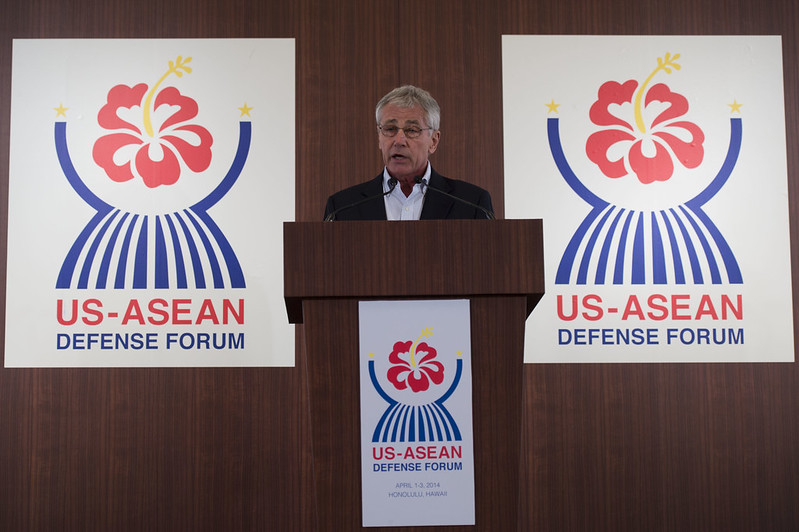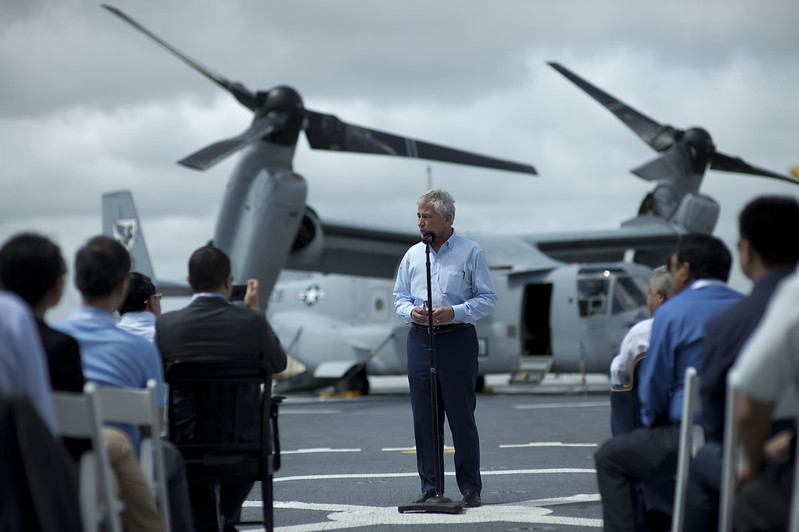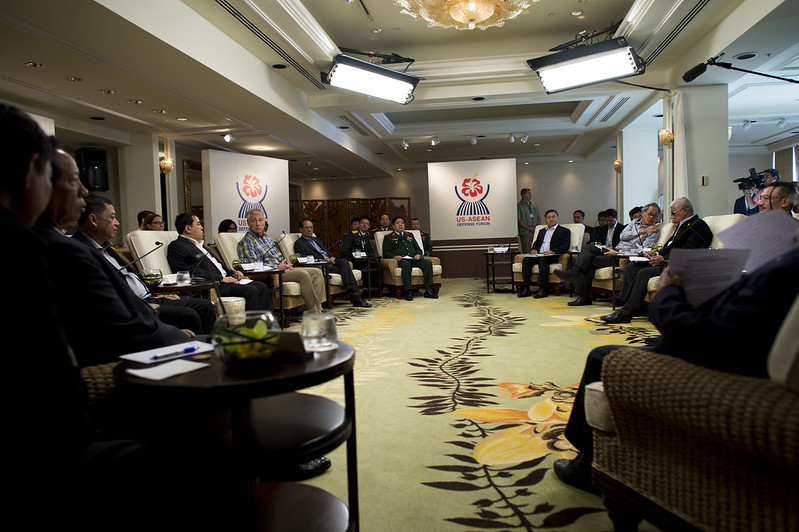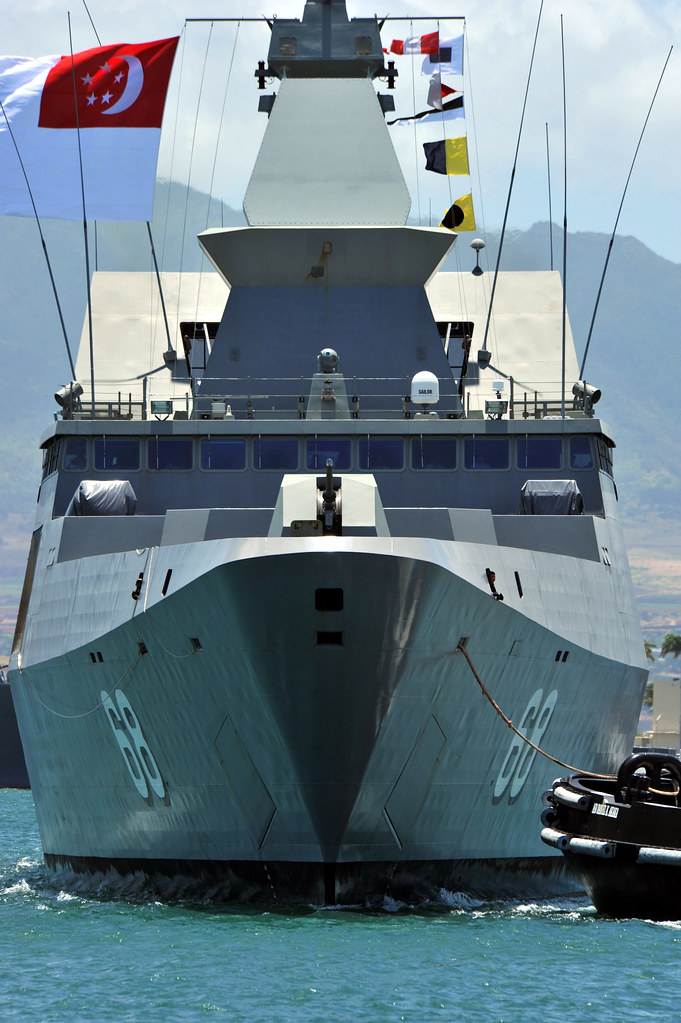RIMPAC 2014 and the Shifting Winds of Change in Asia (Part 1 of 7)
Below, US Vice-Admiral Kenneth Floyd (center), commander of the US Third Fleet who serves as this year's RIMPAC Combined Task Force Commander, visits the Chinese PLA Navy supply ship Qiandaohu in Pearl Harbor, Honolulu, Hawaii, on Saturday morning, accompanied by captain Tu Jinhu (second from left). [Photo by Ju Zhenhua for China Daily]
Ships from the PLAN have been invited back for RIMPAC 2016. It was
reported that Commander of U.S. 3rd Fleet — Vice Adm. Kenneth Floyd — extended the invitation to PLAN Adm. Zhao Xiaogang during a visit to the Chinese ships.
1. Easing tensions and enhancing cooperation between the navies is a big part of the rationale for China’s invitation -- but beyond that, Standard Operating Procedures (or SOPs) also need to be developed and agreed upon to allow pacific navies to work together, should the need arise. Beijing in 2012 said RIMPAC exercises were designed to bolster U.S. relations in the Asia-Pacific while containing China’s emerging navy, pointing to invitations of the Russian and Indian navies as proof. China’s attitude has eased with China participating for the first time. Vice Adm. Xu Hongmeng, deputy commander of China’s navy, told Xinhua that the mission is an important part of efforts to build a new model of relations between China and the U.S In RIMPAC 2014, participating nations will see new SOPs established, and get a chance to work more closely with the PLA(N), the fastest rising naval power in the world. Thereafter, three of the Chinese vessels are scheduled for a port visit in San Diego; and the Peace Ark will sail to Tonga, Fiji, Vanuatu, and Papua New Guinea for a medical mission.
Franz-Stefan Gady a Senior Fellow at the EastWest Institute also noted:
"China’s participation in the RIMPAC exercise is a clear signal that neither the United States nor the People’s Republic are interested in a deterioration of military-to-military relations. In fact, RIMPAC 2014 is part of a larger effort of senior military and civilian leadership in both countries to deepen military ties.
...
In China, participation in RIMPAC 2014 is seen as a concrete achievement in carrying out Xi Jinping’s call for stronger U.S.-China military relations. PLA Deputy Navy Commander Xu Hongmeng called PLAN involvement in RIMPAC an “important part” of stronger U.S.-China military relations...
According to Alexander Sullivan, Research Associate at the Center for a New American Security, China wants to demonstrate with its participation in RIMPAC that it is a serious regional maritime and political power—equal to or greater than Russia and India, who participated in the 2012 iteration—and to burnish its credentials on cooperation and confidence-building."
Below, the Surgeon General of the United States Navy recently visited the Chinese medical ship
Peace Ark. This tour was the final portion of the International Military Medical Symposium, held July 1-2, which allowed members throughout the international military medical community to better enhance their knowledge and experience.
2. Also for the first time at RIMPAC, two hospital ships, USNSMercy and PLA (N) Peace Ark, will participate in a humanitarian assistance/disaster relief event as part of the exercise -- with an emphasis is being placed on military support to humanitarian assistance and disaster recovery, evacuation operations from unstable areas, peace-enforcement, and peace-keeping. A 2013 RAND report (
PDF) points to some lessons in humanitarian assistance/disaster relief. However, as
Doug Bandow, Senior Fellow at the Cato Institute noted:
"Beijing’s participation comes at a time of significant regional tension. Most of which is maritime. The PRC’s more aggressive stance in asserting its territorial claims in the South China Sea and Sea of Japan have led to threatening confrontations with Japan, the Philippines, and Vietnam. It is widely believed that China’s military has been particularly vocal internally in pressing more extreme demands on the PRC’s neighbors.
RIMPAC offers an opportunity to create at least some countervailing pressure in favor of a less threatening regional naval environment. At the political level inviting Beijing to participate demonstrates respect for China’s increased military power and international role. Doing so also counters the charge that Washington is seeking to isolate and contain the PRC.
...
The last couple of years have not been kind to the PRC’s “peaceful rise.” America and China’s neighbors increasingly are looking at Chinese naval vessels as a threat. However, RIMPAC showcases them in a different role. It will be up to Beijing, its Pacific neighbors, and the U.S. to find other opportunities to further invest the PRC in the existing geopolitical order.
Doing so won’t be enough to keep the peace in the decades ahead. But it would nonetheless be a useful step in the right direction."

Above, June 25, 2014, PLA(N) Haikou (DD 171) arrives at the Joint Base Pearl Harbor Hickam to participate in RIMPAC 2014. The Chinese fleet is composed of a missile destroyer, a missile frigate, a supply ship, a hospital ship, two helicopters with about 1,100 sailors and officers that include divers, and a medical team.
3. The theme of RIMPAC 2014 is "
Capable, Adaptive, Partners". The participating nations and forces will exercise a wide range of capabilities and demonstrate the inherent flexibility of maritime forces. These capabilities range from disaster relief and maritime security operations to sea control and complex warfighting. The relevant, realistic training syllabus includes amphibious operations, gunnery, missile, anti-submarine and air defense exercises as well as counter-piracy, mine clearance operations, explosive ordnance disposal and diving and salvage operations. Below is the extract of the statement by
Adm. Harry Harris Jr.:-
Below, Adm. Harry Harris Jr., commander of PACFLT, is surrounded by senior international leadership as he announces the official start of RIMPAC 2014 during a press conference on Joint Base Pearl Harbor-Hickam. (U.S. Navy photo by Mass Communication Specialist 2nd Class Diana Quinlan/Released)
"Today, maritime cooperation is more vital than ever before. For centuries, the world's oceans kept us apart, but in this increasingly globalized world, they are the pathways that bring us together. Freedom of the seas is the minimum condition necessary for global prosperity and trade to flourish. This applies to the United States, a maritime nation and a Pacific nation, and it applies to each of the countries participating in RIMPAC.
As the world's economic center of gravity shifts rapidly toward the Indo-Asia-Pacific, we also note the increasing risks in the region - some man-made, some natural - but all capable of disrupting stability and impacting our collective prosperity. We can all appreciate that conflict and crisis are bad for business. I think it's important to note that by simply attending RIMPAC, every nation here is making the bold statement that we must improve multinational military cooperation despite disagreements. We can agree to disagree without being disagreeable. Capable maritime forces enhance stability, security, prosperity and peace around the world, especially in an ocean as vast as the Pacific. The 22 nations who sent forces to RIMPAC have interests in the Pacific, and they know that this exercise will help them improve their capability to operate with each other and contribute to multilateral efforts when needed.
Mutual trust and open lines of communication are critical, but are very challenging to build. That's why multilateral exercises like RIMPAC are so important. It helps us work together effectively in real world events like the recent search for Malaysia Airliner MH370, or in responding to the devastating typhoon that hit our friends in the Philippines last November. Friends help friends, and often, the fastest response to crisis comes from the sea.
Capable maritime forces matter to all nations.
And they matter to the United States, which is conducting a whole-of-government strategic rebalance to the Pacific. The rebalance is based on a strategy of cooperation and collaboration, and that's why it is imperative that we work together to build trust and confidence to solve our collective maritime challenges. When great nations work together, we can accomplish great things. Collaboration and cooperation, that's why we are here to learn together, operate together and sail together."
Above, a patient with a mock injury is treated during emergency disaster training on board USNS Mercy (U.S. Navy photos by Mass Communication Specialist 3rd Class Pyoung K. Yi/Released)

Above, June 25, 2014, the Military Sealift Command hospital ship USNS Mercy (T-AH 19) passes the USS Missouri memorial as the ship arrives in Hawaii for RIMPAC 2014 (U.S. Navy photo by Mass Communication Specialist 2nd Class Tim D. Godbee/Released).
4. Like the US, ASEAN itself is not a party to the maritime disputes in the South China Sea or in the East China Sea. On the one hand, ASEAN member states:-
(i) are finding a way to move on to manage the issue with China (including the crucial task of keeping the lines of communications open between China and ASEAN member states). Most ASEAN members seek to improve their relationship with the US and China at the same time with some more beholden to aid from one side; and
(ii) have given voice to concerns of Vietnam and the Philippines at numerous international events (to assist Vietnam and the Philippines in voicing their concerns).
Above, June 18, 2014, a multinational task force consisting of ships from Brunei, Singapore, the People’s Republic of China and the United States, transits the Pacific in formation during a group sail from Guam to Pearl Harbor (U.S. Navy photo by Mass Communication Specialist 2nd Class Brian T. Glunt/ Released)
5. On the other hand, China too has sought to advance its military ties with Singapore as early as November 2005, with a visit to Singapore by Wu Bangguo (vice-chairman of the CMC) and General Cao Gangchuan (Minister of National Defence). This visit eventually paved the way for the COOPERATION series of the joint counter-terrorism training exercises between the PLA (PLA Emergency Response Office and Guangzhou Military Region) and the SAF (with units from the 2PDF and the CBRE Defence Group), under the auspices of the bilateral Agreement on Defence Exchanges and Security Cooperation in January 2008. The COOPERATION joint counter-terrorism training exercises were held in
June 2009 at Guilin, China and in November 2010 at Singapore.
COOPERATION 2010 was a nine-day exercise. It consisted of 60 personnel from the SAF and 86 personnel from the PLA. Joint bilateral military exercises with China is not unique to Singapore. Indonesia (eg. Exercise Knife Sharp, anti-terror joint military exercise), Thailand (eg. Exercise Strike, a joint counter-terrorism exercise; and Exercise Blue Strike, an exercise between Thai and Chinese marine units), and Indonesia (eg. Exercise Knife Sharp, anti-terror joint military exercise). ASEAN member states promoted the concept of regional autonomy to prevent any one power from exercising hegemony over Southeast Asia. ASEAN’s assertion of regional autonomy took two forms.
One, it involved the expansion of membership from its initial core of five to ten of South East Asia’s eleven states.
Two, ASEAN’s assertion of regional autonomy also took the form of political declarations and treaties covering Southeast Asia. In recent years ASEAN has advanced the concept of regional autonomy by ratifying the ASEAN Charter and setting the goal of creating an ASEAN Community by 2015. ASEAN's approach in relations with external powers has been to assert its centrality in the region’s security architecture -- this includes the creation of ADMM Plus 8 (see this thread,
here, for additional information).
The strategy's manifestation for many of the ASEAN members is via non-alignment (with the exception of the Philippines and Thailand, who are US allies) and the general unwillingness of most ASEAN members to take a side on conflicts/rivalry between the plus 8 powers. Indonesia with regards to the great powers has argued for a policy of ''
dynamic equilibrium'' with no one power dominating (or what Singapore's defence minister would call an inclusive security architecture).
Below, June 27, 2014, the amphibious assault ship USS Peleliu (LHA 5) transits into Joint Base Pearl Harbor-Hickam in preparation for the ship's participation in RIMPAC 2014 (U.S. Navy photo by Mass Communication Specialist 2nd Class Brian T. Glunt /Released).

6. About 700 Hawaii-based US Marines, sailors and allied land forces will deploy across three widely dispersed training areas in Hawaii. Members of 3rd Battalion, 3rd Marines, out of US Marine Corps Base Hawaii, will split into three company landing teams and cope with the challenges of self-sustainment. One of the company landing teams will arrive via amphibious assault vehicle. Some of the equipment they’ll be using will be transported by a small-scale prototype of the Ultra Heavy-Lift Amphibious Connector. The exercise simulates an unstable situation in the Pacific following a natural disaster, said Lt. Col. Charles Berry, head of the Warfighting Lab’s Field Testing Branch. Two of the three teams of 3/3 Marines will be inserted to the area by air and one by amphibious assault vehicle. The experiment follows the April 2014 release of the US Marine Corps’ new 10-year concept of operations, called
Expeditionary Force 21, which details future mission types based around rapid crisis response handled by units as small as company landing teams. The US Marines will also be working with land component forces from Australia, Japan, Malaysia, Mexico, New Zealand, Tonga and so on. Twenty-first century amphibious manoeuvre, underpinned by concepts like Ship-To-Objective Manoeuvre and Sea Basing, are about avoiding direct engagement when lodging a force from the sea to the land objective. There are may ways to use amphibious forces. Let me provide three examples of how amphibious ships could be used:
Below, troops from The 3rd Battalion, Princess Patricia's Canadian Light Infantry Recce Platoon, 3 Section, The 3rd Reconnaissance Battalion, "A" Company, Third Platoon, United States Marines and The Japanese Western Area Infantry Regiment, use combat rubber reconnaissance crafts to complete Nautical Navigation and Over the Horizon Training at Kaneohe Bay, Marine Corps Base Hawaii during RIMPAC on June 29, 2014. Photo: Sgt Matthew McGregor, Canadian Forces Combat Camera.
(i) To conduct a raid from the sea could be undertaken by sea-based special forces against a terrorist group to recover hostages, or to seize materials related to weapons of mass destruction from terrorists.
(ii) To conduct an amphibious demonstration, through presence, could provide a cost-effective way to deter aggression or to shape the geo-political environment.
(iii) To use as a venue to host a great party (as the Japanese are demonstrating in the picture below). Sea power is not a natural attribute of statecraft; but the Japanese have it and certainly know how to use it to the good effect, as a maritime nation.
Above, Japan Maritime Self Defense Force Rear Adm. Yasuki Nakahata welcoming guests onboard JS Ise (DDH-182), as part of RIMPAC 2014.
7. RIMPAC 2014 will be led by U.S. Vice Adm. Kenneth Floyd, commander of the U.S. Third Fleet (C3F), who will serve as the Combined Task Force (CTF) Commander. Royal Australian Navy Rear Adm. Simon Cullen will serve as deputy commander of the CTF, and Japan Maritime Self Defense Force Rear Adm. Yasuki Nakahata as the vice commander. Other key leaders of the multinational force will include Rear Adm. Gilles Couturier of the Royal Canadian Navy, who will command the maritime component, Air Commodore Chris Westwood of the Royal Australian Air Force, who will command the air component, and the land component will be led by Marine Corps Maj. Gen. Richard Simcock. RIMPAC 2014 will also include for the first time a special operations component, to be led by U.S. Navy Capt. William Stevens.
Above, recon elements of the Japan Ground Self-Defense Force securing a beach at RIMPAC 2014 (Copyright © JSDF).
Above, a member of the Japan Ground Self-Defense Force waits inside a MH-53E Super Stallion, assigned to Marine Heavy Helicopter Squadron 463 "Pegasus", before conducting Helicopter Rope Suspension Training and amphibious insert capabilities with the Marines of 3rd Marine Division, III Marine Expeditionary Force, and 3rd Battalion Princess Patricia's Canadian Light Infantry during RIMPAC 2014 (U.S. Navy photo by Mass Communication Specialist 1st Class Shannon E. Renfroe/Released).




































































































































































